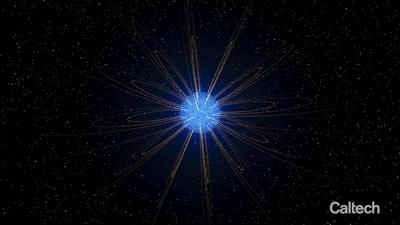Some people are two-faced – figuratively speaking, of course. In Roman mythology, the god Janus literally had two faces—one looking forward and the other looking back, representing transformations and duality. But what if she was a star with two faces? Yes, it also exists.
A team of scientists observed a white dwarf star — the hot remnants of a star that is the densest object in the universe — and named it Janus, precisely because it has the distinction of being made of hydrogen on one side and helium on the other.
“Janus is the Roman god with two faces, so we thought it was very appropriate. Moreover, Janus is the god of transitions and a white dwarf can go from an atmosphere made of hydrogen to one made of helium,” explains Ilaria Caizo, an astrophysicist at Caltech, in the US, who is responsible for the work now published in magazine nature.
K. Miller/Caltech
This star is located in our galaxy, the Milky Way, about 1,300 light-years from Earth. A light year is the distance that light travels in one year, about 9.5 trillion kilometers.
Janus is very massive for a white dwarf, its mass is 20% greater than our Sun, but it is compressed into a body half the diameter of Earth. This star rotates on its own axis every 15 minutes – which is pretty fast, considering that stars usually take between a few hours and a few days to complete this motion.
“White dwarfs form at the end of a star’s life. About 97% of stars are destined to become white dwarfs when they die,” says Ilaria Kayazu.
“Our sun, for example, is currently burning hydrogen into helium in its core. When the hydrogen runs out, the sun will start burning helium into carbon and oxygen. And when the helium in the core also runs out, the sun will expel its outer layers into space, in what is called a planetary nebula – and the core will slowly shrink until it becomes a white dwarf,” summarizes the researcher from Caltech.
The good news for earthlings is that it will be another 5 billion years before this happens to our sun.
The culprit could be the magnetic field
Janus was discovered by an observing array on a telescope, the Zwicky Transit Facility, at Palomar Observatory in California, with further observations to be made by other ground-based telescopes.
After a white dwarf forms, its heaviest elements sink to the star’s core, while the lighter elements—hydrogen being the lightest, followed by helium—float to the top. Janus may be a white dwarf in the middle of the transition, but is distinguished by having one side with hydrogen and the other with helium.
Researchers believe its magnetic field may be responsible for this asymmetry. If the magnetic field on one side is stronger than the other, as is often the case with celestial bodies, one side may contain a lesser mixture of elements, thus becoming heavy hydrogen or heavy helium.
“Many white dwarfs must have gone through this transition, and we may have been caught in the act of one, due to the formation of the magnetic field,” adds Ilaria Caiazzo. Janus isn’t the only white dwarf we’ve seen. Ilaria Caiazzo belongs to a science team that presented, in 2021, a white dwarf with a small diameter (slightly larger than our moon) that boasted the largest mass and smallest size of any known white dwarf.
“When we look at the stars from a different angle, we are surprised and sometimes even puzzled,” says the scientist. “The stellar phenomena are very rich and no two stars are the same if you look at them closely.”

“Friendly zombie fanatic. Analyst. Coffee buff. Professional music specialist. Communicator.”

